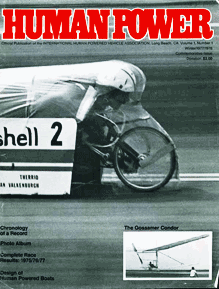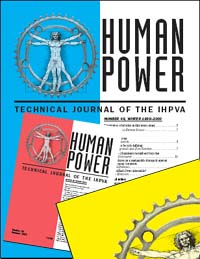Human Power‘s First Issue
by Chester R. Kyle
The first issue of Human Power was printed in 1977 and, unlike many amateur first issues, it was spectacular. It was put together by a professional graphic artist, Dick Hargraves, in slick magazine format, with a dramatic photo of the winner of the 1977 HP Speed Championships spread clear across the front and back covers. The vehicle was Paul Van Valkenburgh’s Aeroshell, a prone hand-and-foot-powered four-wheeled streamliner. You can just make out USA champion cyclist Paul Therrio’s head leading the way under the clear plastic fairing.
The first issue contained an article by Dr. Paul MacCready, who had just won the Kremer Prize for human-powered aircraft, and another by engineer Randy Danta on the design of human-powered boats. It also included the results of the first three International Human-Powered Speed Championships in 1975, 1976 and 1977 with photos of all of the 1977 entries.
The officers and board of directors of the IHPVA were listed on page 11 along with their biographical data. Included were such notables as: Allan Abbott, holder of the World Motor-Paced speed record of 140.5 mph; Tullio Campagnolo, owner and president of Campagnolo – then the largest racing-component manufacturer in the World; Sir Hubert Opperman, O.B.E. Australian Member of Parliament and renowned holder of numerous long-distance cycling records (example, Lands End, England, to John O’Groats, Scotland, in 63 hours 22 minutes in 1929); Eddy Merckx of Belguim, many time winner of the Tour de France; and of course there were famous authors Frank Whitt and David Gordon Wilson, creators of the best-selling cycling book, Bicycling Science. I have letters of acceptance from them in my files. I was the president that year and my co-founder of the IHPVA, Jack Lambie, was vice president of air. Jack was responsible for the resurgence of hang gliding as a sport in the USA, when he built and flew the hang glider “Hang Loose” in the early 1970s. He also built a streamlined bicycle in 1973 at the same time I built the Teledyne Titan. These were the first two streamlined HPVs built in North America.
Jack and I had started the Human-Powered Speed Championships in 1975 and we were forced to organize the IHPVA in 1976 due to an annoying quirk of the Guinness Book of World Records. Guinness would not recognize our human-powered speed records because they were not sanctioned by an official organization. So we formed one, the IHPVA, and later, in 1979 and 1980, Guinness actually printed our records. The IHPVA is still going, and Human Power is still published – a modern miracle considering the odds against.
In 1977, Dick Hargraves suggested and volunteered to put out the publication called Human Power. Dick was a talented jazz pianist, as well as a model-airplane builder – a thread that runs through the IHPVA: Paul MacCready, Bill Watson, Alec Brooks and many other first members of the IHPVA were amateur model builders. In 1976, Dick also designed and printed our first race poster. Common to most publishers, Hargraves found it was a tremendous task to put out an issue by himself, so he enlisted the help of engineer and automotive author Paul Van Valkenburgh and many others in publishing Human Power for the next several years. Hargrave remained as editor until the end of 1983, when Dave Wilson took over as editor. Although the slick magazine format disappeared after the first issue, Hargrave’s logo and layout remained until 1991, when Dave transformed Human Power into the attractive technical journal with colored cover that exists today.
The first issue of Human Power was a remarkable introduction to a journal that has printed almost 200 technical articles to date, many authored by the world’s leaders in the human-power movement. The authors have designed and built some of the world’s most successful, original and creative human-powered vehicles, land, water and aircraft, and have written about it in Human Power. This collection, which contains all of the issues published over 26 years, will remain as an essential reference to those who really want to know what makes human-powered vehicles work.
May 14, 2004




